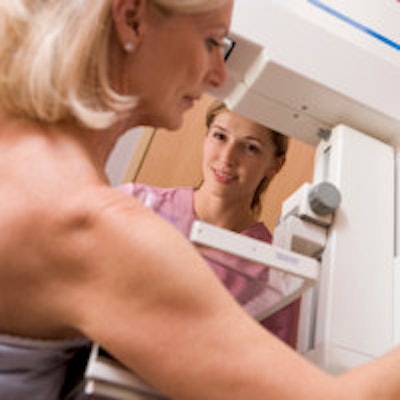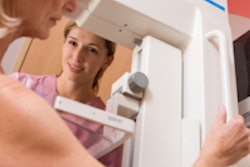
Medicare is paying millions of dollars for new breast imaging technologies for older women that aren't having a measurable effect on cancer detection, according to a new study published July 1 in the Journal of the National Cancer Institute.
Researchers from Yale University examined the use of new imaging modalities such as full-field digital mammography (FFDM) and computer-aided detection (CAD) in a population of 270,000 women with a mean age older than 75, the upper limit for most screening recommendations. They compared technology use and costs in two two-year time periods when new technology was proliferating.
Their conclusion? Medicare appears to be paying almost $150 million more a year on a national basis for new technologies to screen these older women, without any significant change in the detection rate for early-stage cancer (JNCI, July 1, 2014).
"Our data suggest that the use of these newer modalities was accompanied by a statistically significant increase in costs but no change at stage at diagnosis," wrote a team led by Dr. Cary Gross.
Technology explosion
An explosion of new technology has taken place in breast screening over the past 15 years, with the availability of new modalities such as FFDM, CAD, breast MRI, and breast ultrasound, the researchers noted. The hope is that these new technologies will enable breast imagers to catch cancer earlier, thus saving more lives.
But there are signs that this armamentarium might not be appropriate for all women, the authors wrote. Studies demonstrating the benefit of digital mammography and CAD in improving cancer detection have mostly left out older women, yet these new technologies are being adopted quickly in this population.
 Dr. Cary Gross of Yale University.
Dr. Cary Gross of Yale University.To measure the impact of the shift, the researchers examined utilization rates of new technology, spending levels, and detection rates for early-stage cancer in women 66 years and older who were enrolled in Medicare at two time points: 2001-2002 and 2008-2009. They theorized that the advanced technologies should lead to more detection of cancer at earlier stages.
The study population consisted of two random samples of women: The first included 137,150 women with a mean age of 76.0 years who received mammograms from 2001-2002, and the second included 133,097 women with a mean age of 77.3 years who received mammograms from 2008-2009.
The researchers said they selected these time points because they represented periods when new screening technologies were being adopted into clinical care. In addition, the latter one was the most recent time period available to ascertain cancer incidence and stage shift in the Surveillance, Epidemiology, and End Results (SEER) database, which was used to track outcomes.
The researchers found little change in some aspects of screening; for example, overall screening rates were largely the same, at 42.0% in the 2001-2002 cohort and 42.6% in the 2008-2009 cohort. The use of diagnostic mammography increased only slightly, from 5.3% in the earlier group to 7.1% in the later group. The number of women 75 and older being screening was also relatively steady, at 32.4% in the earlier period and 32.6% in the later period.
But other changes were far more profound. The use of digital image acquisition rose from 2.0% to 29.8% between the two study periods, while the use of CAD jumped from 3.2% to 33.1%.
Such use of technology appeared to be related to higher Medicare costs as well. The cost of screening mammography per capita increased 43% over the study period, growing from $44 per capita to $63 per capita, while the cost per screening mammogram went from $75 to $101.
They also saw an overall increase in Medicare spending, from $666 million in the first two-year period to $962 million in the later two-year period, representing growth of 44%. The researchers estimated that digital image acquisition contributed a $45 increase per capita, while screening mammography CAD added $5 per capita.
Despite the rising costs, there was no statistically significant change in detection rates between either study group for early-stage cancer (classified as in situ and stage I disease), the group found. The earlier cohort had a cancer detection rate of 2.45 cancers per 1,000 person-years, compared with a detection rate of 2.57 for the later group, a difference that was not statistically significant (p = 0.41). Overall cancer incidence was 4.22 per 1,000 person-years in the early cohort and 4.30 person-years in the later cohort.
The incidence of late-stage disease also did not change on a statistically significant basis between the groups, standing at 0.20 per 1,000 person-years in the early cohort and 0.23 per 1,000 person-years in the later cohort. There was no statistically significant difference in stage or tumor size over time in women diagnosed with cancer.
The only positive news was that there was a slight decline in the biopsy rate, Gross and colleagues wrote. It dropped from 20 biopsies per 1,000 women to 17 biopsies per 1,000 women.
Sign of a broader problem?
In a conversation with AuntMinnie.com, lead author Gross said the results of the study reflect a broader problem with U.S. healthcare: the adoption of new technologies that haven't been proved to improve patient outcomes.
"There is a widespread belief in the American healthcare system that newer is better," Gross said, even as "there is virtually no evidence that these newer technologies are better or more effective in terms of saving lives and improving patient outcomes in older women."
The authors speculated that new technologies were adopted due to several factors, such as patient and physician demand, as well as reimbursement policies that enable doctors to charge more for new technologies.
But mammography isn't the only technology that has contributed to higher costs without an improvement in patient outcomes, he said. Examples include prostate-specific antigen (PSA) screening and robotic prostate surgery.
What's the solution? Now that the genie is out of the bottle, it would be difficult if not impossible to stop using new technologies such as digital mammography and CAD in older women. And halting Medicare payment isn't realistic either, as Gross estimates that some 90% of technologies being paid for by Medicare do not have adequate data to demonstrate their effect on patient outcomes.
Instead, Gross believes that the U.S. could do a better job of adopting new technologies that are in an earlier phase of implementation -- such as digital breast tomosynthesis (DBT). He sees DBT following the same path blazed by full-field digital mammography, especially given the momentum from a positive paper published on June 25 in the Journal of the American Medical Association that found that DBT boosted the overall cancer detection rate by 29%.
Such a study could be seen as giving the green light to DBT adoption, but Gross pointed out that demonstrating higher cancer detection rates isn't the same as improving patient outcomes. We still don't know DBT's impact on outcomes, he said.
That said, it might not be practical to withhold DBT altogether from women. Instead, Gross would use Medicare's coverage with evidence development (CED) structure, which the U.S. Centers for Medicare and Medicaid Services (CMS) has used to gather evidence on new technologies while allowing providers to be reimbursed for their use.
In medical imaging, the CED structure was most famously used in PET, as part of the National Oncologic PET Registry (NOPR) to gather data on oncology applications for FDG-PET studies. The process ended with CMS granting Medicare coverage for nine oncology PET applications.
Gross said the researchers would like to conduct studies similar to the current one but with longer follow-up periods to determine if it simply takes a longer period of time for new technologies to demonstrate their value. Until then, new technologies such as tomosynthesis should be adopted in the U.S. with a more measured approach than what is currently used, he believes.
"We have to walk a fine line between the need to understand what works and what does not, and the need for new and effective therapies," Gross said. "With tomosynthesis, we could allow women to access it, but with the understanding that with the access we need to collect data."



















